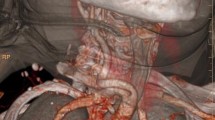Abstract
The common carotid artery (CCA) usually runs along the long axis of the neck, although it is occasionally found in an abnormal position or is displaced. We report a case of an 86-year-old woman in whom the CCA was identified in the submandibular area. The patient visited our clinic and reported soft tissue swelling in the right submandibular area. It resembled a tumor mass or a swollen lymph node. Computed tomography showed that it was the right CCA that had been bent forward and was running along the submandibular subcutaneous area. Ultrasonography verified the diagnosis. No other lesions were found on the diagnostic images. Consequently, the patient was diagnosed as having abnormal CCA positioning. Although this condition generally requires no treatment, it is important to follow-up the abnormality with diagnostic imaging because of the risk of cerebrovascular disorders.





Similar content being viewed by others
References
Del Corso LD, Moruzzo D, Conte B, Agelli M, Romanelli AM, Pastine F, et al. Tortuosity, kinking, and coiling of the carotid artery: expression of atherosclerosis or aging? Angiology. 1998;49:361–71.
Ozcan KM, Ozcan I, Selcuk A, Pasaoglu L, Hatipoglu HG, Dere H. Tortuous internal carotid artery narrowing pyriform sinus: two cases. Clin Imaging. 2008;32:220–2.
Hosokawa S, Mineta H. Tortuous internal carotid artery presenting as a pharyngeal mass. J Laryngol Otol. 2010;124:1033–6.
Matsumoto Y, Yokoi H, Kohno N. [A case report of dislocation of the common carotid artery.]. J Jpn Soc Head Neck Surg. 2012;22:169–72. (in Japanese).
Metz H, Murray-Leslie RM, Bannister RG, Bull JWD, Marshall J. Kinking of the internal carotid artery in relation to cerebrovascular disease. Lancet. 1961;1:424–6.
Weibel J, Fields WS. Tortuosity, coiling, and kinking of the internal carotid artery. II. Relationship of morphological variation to cerebrovascular insufficiency. Neurology. 1965;15:462–8.
Leipzig TJ, Dohrmann GJ. The tortuous or kinked carotid artery: pathogenesis and clinical considerations: a historical review. Surg Neurol. 1986;25:478–86.
Koskas F, Bahnini A, Walden R, Kieffer E. Stenotic coiling and kinking of the internal carotid artery. Ann Vasc Surg. 1993;7:530–40.
Phan TG, Beare RJ, Jolley D, Das G, Ren M, Wong K, et al. Carotid artery anatomy and geometry as risk factors for carotid atherosclerotic disease. Stroke. 2012;43:1596–601.
Deterling RA. Tortuous right common carotid artery simulating aneurysm. Angiology. 1952;3:483–92.
Vannix RS, Joergenson EJ, Carter R. Kinking of the internal carotid artery: clinical significance and surgical management. Am J Surg. 1977;134:82–9.
Mukherjee D, Inahara T. Management of the tortuous internal carotid artery. Am J Surg. 1985;149:651–5.
Nagata T, Masumoto K, Hayashi Y, Watanabe Y, Kato Y, Katou F. Three-dimensional computed tomographic analysis of variations of the carotid artery. J Craniomaxillofac Surg. 2016;44:734–42.
Kelly AB. Tortuosity of the internal carotid in relation to the pharynx. J Laryngol Otol. 1925;40:15–23.
Weibel J, Fields WS. Tortuosity, coiling, and kinking of the internal carotid artery. I. Etiology and radiographic anatomy. Neurology. 1965;15:7–18.
Author information
Authors and Affiliations
Corresponding author
Ethics declarations
Conflict of interest
Nakamoto T, Suei Y, Konishi M, Kanda T, Verdonschot RG, and Kakimoto N declare that they have no conflict of interest.
Human rights statement
All procedures followed were in accordance with the ethical standards of the responsible committee on human experimentation (institutional and national) and with the Helsinki Declaration of 1975, as revised in 2008.
Informed consent
Informed consent was obtained from the patient for her involvement in this study.
Rights and permissions
About this article
Cite this article
Nakamoto, T., Suei, Y., Konishi, M. et al. Abnormal positioning of the common carotid artery clinically diagnosed as a submandibular mass. Oral Radiol 35, 331–334 (2019). https://doi.org/10.1007/s11282-018-0355-7
Received:
Accepted:
Published:
Issue Date:
DOI: https://doi.org/10.1007/s11282-018-0355-7




